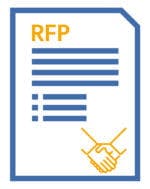The request for proposal (RFP) lite may be the best strategic sourcing process you’ve never heard of. Also called a short-form RFP, this new type of RFP benefits both procurement and proposal professionals. With a simple RFP template, you have a faster route to results.
In this blog, I’ll offer an overview of the RFP lite and explore the benefits of using one. In addition, I’ll provide examples of when to use a short-form RFP and tips for leveraging this tool. Finally, I’ll give several simple RFP template examples. With these tools, you’ll have everything you need to shorten your RFPs as well as the RFP process.
What is an RFP lite?
An RFP lite, also called a simple RFP or short-form RFP, is an abbreviated version of the traditional request for proposal. Indeed, an RFP lite may have as few as 10 questions. Accordingly, the questions are highly focused on the specific procurement project. Conversely, a traditional RFP covers an array of topics and may be hundreds of questions long.

Why simplify?
If you’ve ever responded to an RFP or evaluated RFP responses, you know how laborious they are. Both procurement and proposal professionals invest a lot of time into the process. Unfortunately, results are not guaranteed.
Traditional RFPs take a long time to write and even longer to review. Formal RFPs that involve a lot of vendors create an incredible amount of data to be scored, compared and evaluated. For example, a 200-question RFP sent to 5 vendors creates 1000 total responses. Even with RFP software that enables automated weighted scoring, it’s an overwhelming amount of information.
In addition to longer RFPs being a burden to procurement managers, they’re also a gamble for the vendors who respond to them. When vendors receive a traditional RFP, they must carefully consider their decision to bid or not to bid. The proposal team must weigh a number of factors including the time cost of responding, current workloads and likelihood of winning. Ultimately, this means that your RFP may not receive a response from your preferred vendor or the most qualified vendor. An article from the Chartered Institute of Procurement & Supply puts it like this:
“The ultimate goal of every RFP should be to entice all relevant suppliers to submit a bid, which drives higher competition and a better savings opportunity for the buying organisation. Put yourself in the shoes of a supplier. Lengthy RFPs take massive amounts of time and manpower to answer, and at some level, those extra costs are passed onto the buyer.”
Benefits of the simple RFP approach
The short-form RFP solves many of the challenges posed by the traditional RFP for everyone that works with them. For procurement managers, creating the document using a simple RFP template is fast and easy. In addition, there’s less time invested and less risk in responding for vendors. There are additional benefits that result from using the RFP lite like:
Faster RFP creation
Once you’ve created a simple RFP template, you’ll be able to use it over and over again to save time. First, gather the requirements and background for the project from your stakeholders and executives. Then, start customizing your simple RFP template. It shouldn’t take much to update as long as you stick to asking project-specific questions.
Ability to include a larger variety of vendors
For new procurement projects, it can be helpful to cast a wide net. The speed and simplicity of the RFP lite enables you to share your RFP with vendors who you may not have otherwise considered. For example, it’s easy to include vendors new to the industry, local and national companies, startups and well-known companies.
Better responses and a shortened RFP timeline
This benefit is pretty simple. Because there are fewer questions, your vendors can respond more quickly. Consequently, using an RFP lite leads to much shorter RFP timelines.
In addition, short-form RFPs often come with a strict page limit so vendors aren’t tempted to answer questions that weren’t asked. Because brevity is required, the supplier must put their best foot forward and present their most creative ideas succinctly. A blog by Optimizer Online discusses the results of a two-page RFP lite process saying,
“All of the responses came in well under the 20-page limit — and were extremely responsive to the requirement in the RFP to cut straight to the chase and to eliminate all but the most important things a prospective customer needed to know. So the responses, which were indeed light in volume, were heavily loaded with relevant info, and not “lite” at all.”
Greater vendor participation
As I mentioned above, vendors must weigh the level of effort and likelihood to win when responding to RFPs. So, using a simple RFP presents a lower cost of entry on vendors at the beginning of the process. As you narrow down to a short list, vendors know their chances of winning have gone up. Therefore, they’re able to invest more time into answering second-round questions.
Easier evaluation and scoring
Thanks to the short-form RFP approach, vendor management and evaluation are easier. Overall, there are fewer questions and back and forth with vendors during the RFP process. In addition, evaluating proposals becomes much more simple. Scoring answers from 10 vendors becomes a lot less daunting if you only asked them 10 questions.
Ultimately, all of these benefits add up and result in an overall decrease in the cost of procurement. The gain in efficiency empowers procurement teams to be a strategic partner to the business.
When to use a simple RFP template
Not every situation will be a good fit for the RFP lite process. Indeed, in procurement, the right tool makes all the difference, and there are many to choose from. To start, consider what you want to accomplish with your RFP.
If you’re looking for the lowest price, skip the RFP and issue a request for quotation (RFQ) instead. Alternatively, if finding the most qualified vendor is your highest priority, consider the other RFQ, a request for qualifications. Or, if you’re undertaking a new procurement project and want to hear creative solutions and test the market, select the request for information (RFI) process.
Use a simple RFP template for routine procurement. The process is also well suited for verifying that your incumbent vendor is providing industry-leading services at a competitive price. In addition, the short-form RFP is a good choice for procurement projects that have a well-established industry standard and you’re interested in how they will bring a new perspective to your partnership.
The process is ideal for low-risk projects. However, it’s important to note that while the RFP lite process saves time, it does also require due diligence to be effective. After you’ve arrived at your finalist or shortlist of finalists, send a vendor security questionnaire and any additional documentation. Remember, there’s no replacement for thorough research.
5 tips for using an RFP lite
1. Try a multi-step process
One of the great things about the RFP lite is that it works well in conjunction with other procurement processes. For example, you can gather information from insurance providers in vendor profiles. Then, when you need to issue an RFP for a new provider, you can use a simple RFP template because you already have the vendors’ background, security and other standard information.
David Kutcher, founder of Confluent Forms discusses this multi-tiered process as a part of the future of RFPs saying, “I’ve been seeing organizations get really smart by using an advised, multi-tier RFP process. They use requests for qualifications and requests for information to create a shortlist of providers before it even goes to the RFP.”
Download the Future of RFPs ebook to explore more advice from RFP experts.
2. Provide plenty of context
Your short-form RFP should be brief and have a limited number of questions. However, don’t neglect to include plenty of background information. Be sure to include details about the problem so suppliers can provide tailored answers. An article in Entrepreneur puts it this way: “Many RFPs can be summed up in a single page so why not keep it simple and save time? You won’t fool anyone with your pages and pages of “important company content.” Keep your historical references to on-point examples – consultants only need to read relevant material, the rest is a waste of everyone’s time.”
3. Ask strategic questions
When using a simple RFP template, it’s important to customize it to ask the right questions. Accordingly, it’s wise to include deal-breaker questions. On the other hand, if you’re using an RFP lite to test the market, your questions should focus on factors that might convince you to unseat the incumbent vendor. Regardless of your approach, the questions in your RFP should be designed to prompt insightful, creative responses.
4. Suggest a page limit
Simple RFPs must get right to the point. Likewise, encourage respondents to be brief as well. While we wouldn’t necessarily impose a strict page limit, it is useful to offer a suggestion that answers be as concise as possible. Accordingly, this will challenge vendors to think about what information is most important to convey.
5. Leverage weighted scoring
Even in a short-form RFP, some RFP responses will be more important than others. Assign these questions weights to simplify the evaluation process. In addition to using weighted scoring, asking stakeholders and executives to score the proposal individually rather than in a team. This will encourage everyone to provide honest feedback for further discussion.
Simple RFP template example
British Columbia’s short-form RFP process guide
British Columbia’s procurement team are fans of the short-form RFP. They refer to it as an SRFP and provide a detailed guide for vendors and a two-page, simple RFP template for their internal teams to use. As a prerequisite for responding to an SRFP, vendors must complete a proactive request for qualifications. So, before a vendor bids for work, all of their background information is already vetted.
State Procurement Office of Hawaii
Simple RFP template
While this short-form RFP template is still 23 pages long, it’s much shorter than their traditional form. Much of the length is due to the inclusion of policies and evaluation criteria.
Simple RFP example
In this example, again from the State Procurement Office of Hawaii, you can see the simple RFP in action.
Ultimately, procurement managers can benefit from using the RFP lite process. So go ahead and give it a try.
